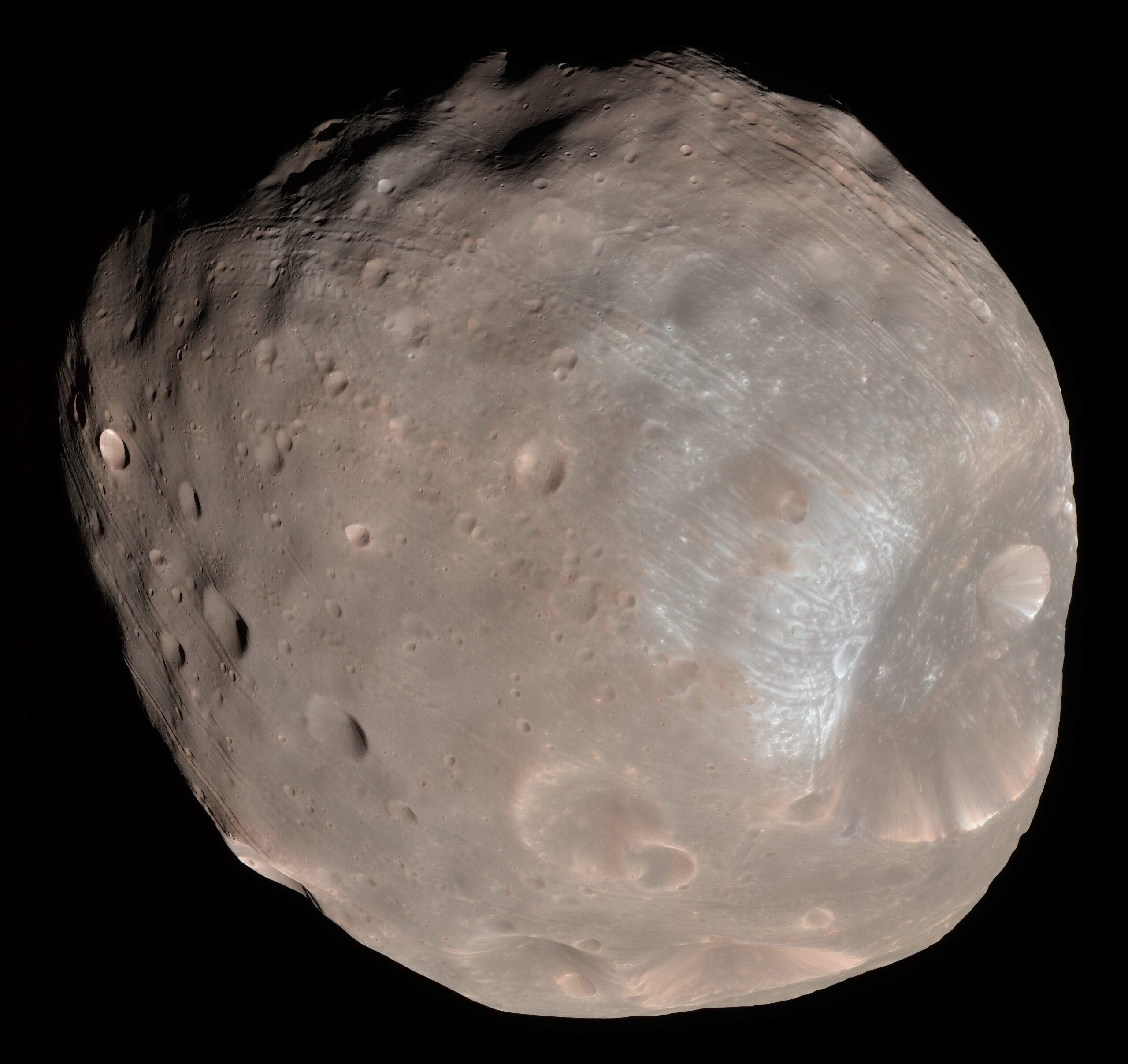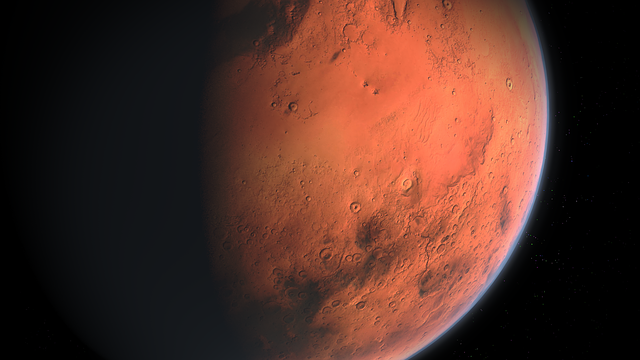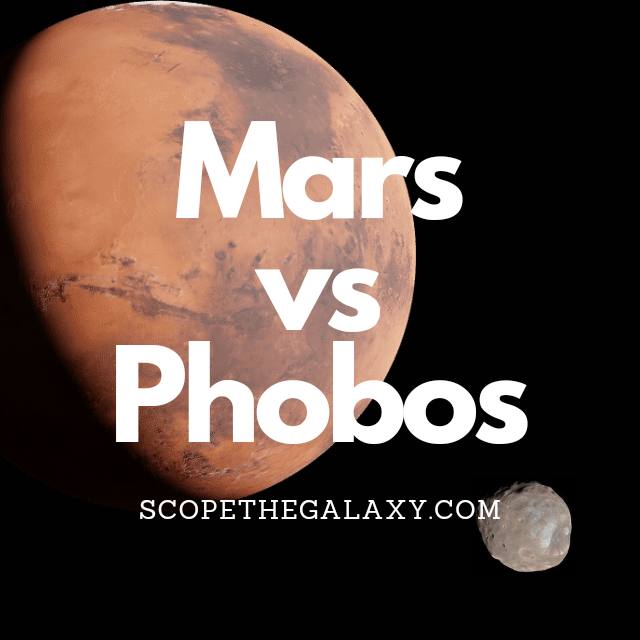*This post may contain affiliate links. This means we may make a commission if you purchase an item using one of our links*
The main differences between Mars and Phobos is that Mars is a planet while Phobos is a natural satellite, Phobos is far smaller with a diameter of 22.53km while Mars has a diameter of 6,779km and Phobos is tidally locked to Mars while Mars is not tidally locked to anything.
For a more detailed look at both Mars and its moon Phobos along with their similarities and differences, continue reading as it will be covered below.
What Is The Moon Phobos?
Table of Contents

Phobos is the larger and innermost of the Martian moons, named after the Greek God of fear and panic. This rocky satellite measures approximately 27 x 22 x 18 kilometers and possesses an irregular shape.
Flying only 270 km above Mars’s surface, Phobos orbits the Martian surface so closely that it spins around the planet three times a day (each orbit takes 7 hours and 39 minutes). And this proximity means that the moon cannot always be seen from Mars’ surface (it all depends on where you’re standing).
In general, Phobos rises in the west, passes through the sky in around 4 hours, and sets in the east. And this process occurs twice during one Martian day.
Phobos travels 1.8 m closer to Mars every 100 years, which means this doomed moon will one day crash into its planet or break up into rings. Still, this won’t happen for another 50 million years or so.
The moon is covered in streak patterns from impact craters, the most significant of which is the crater Stickney, with a diameter of 9.7 km. Phobos has weathered thousands of meteorite impacts, one of which almost shattered it to pieces.
It was first discovered by the American astronomer Asaph Hall on 17th August 1877. But, it can be difficult for astronomers to see as it is one of the least reflective bodies in the solar system with an albedo of 0.071.
Despite its small stature, Phobos experiences wildly varying temperatures on its dark side compared to the light side. Measurements on the light side of the moon suggest that temperatures can rise to -4 degrees Celsius, a sort of brisk winter’s day that would be cold but tolerable.
In contrast, temperatures on the dark side can drop to -112 degrees Celsius, even though the two areas are just a few kilometers apart. The probable cause is fine surface dust that cannot retain heat, allowing temperatures to drop rapidly.
The low density of Phobos suggests its composition is similar to carbonaceous chondrite meteorites, which could mean that Phobos is a captured asteroid.
What Is The Planet Mars?

Mars, also known as the red planet, is the celestial object that’s the front runner in our entire solar system to become a possible new home for us if terraformed. It is also the 4th farthest planet from the Sun and is one of 4 main line terrestrial planets (not including Pluto) in our solar system.
This means that one year on Mars will take roughly 687 Earth days and a day on Mars is roughly the same as Earth at 24 hours and 37 minutes. It’s axial tilt is also very similar to that of Earth where it is positioned around 25 degrees to the right.
It may not be the largest terrestrial world in our solar system as its diameter is only 6,779km but, it does have the most moons amongst the normal terrestrial planet where two, namely Deimos and Phobos, are currently orbiting the red planet.
Like Earth and the other terrestrial worlds, Mars does have an atmosphere, certainly more visible than that on Mercury but, when compared to Earth’s it is merely 1% of its volume.
As a result it is more susceptible to larger debris striking its surface and is unable to trap in too much heat either. This is why it’s on the colder side with a temperature of around -65 degrees Celsius on average. On the contrary its core is significantly hotter at 1,350 degrees Celsius.
Mars is probably the most explored planet outside of our own, with a multitude of rovers like Sojourner (1997–1997), Opportunity (2004–2018), Spirit (2004–2010), Curiosity (2012–), and Perseverance (2021–) that have landed on the Martian soil to explore it.
Billionaires like Elon Musk and even Jeff Bezos are trying for an opportunity to genuinely have astronauts land on the Martian soil, possibly as early as 2029 so, Mars clearly has a lot interested in its terrain, as a potential substitute for Earth in the future.
Similarities Between Phobos And Mars
Phobos and Mars do have their odd few similarities, which in this case includes the below:
- Both have a rocky surface.
- Both are a spherical shape.
- Both are part of the same solar system.
- Both have no rings surrounding them.
- Both orbit the Sun in 687 days.
Differences Between Phobos And Mars
In regards to the differences between the two, they include the below:
- Phobos orbits Mars whilst Mars only orbits the Sun.
- Mars is a spherical shape while Phobos is not.
- Mars has 2 moons while Phobos has no other objects orbiting it.
- Mars is a terrestrial planet whilst Phobos is a terrestrial based natural satellite.
- Mars has a nearly circular orbit while Phobos has a far more drastic elliptical orbit
- Mars has a diameter of 6,779km whilst Phobos has a diameter of 22.53km.
- Phobos has no atmosphere whilst Mars has an atmosphere that is 1% of Earth’s thickness composed of 95% carbon dioxide 2.6% nitrogen and 1.9% argon.
- A day on Phobos takes 7 hours 39 minutes whilst a Mars day takes 24 hours and 37 minutes.
- It takes Phobos 7 hours 39 minutes to orbit Mars while Mars does not orbit Phobos.
- Phobos’ temperature ranged between -4 to -112 degrees Celsius whilst Mars has an average temperature of -65 degrees Celsius.
- Mars’ density is 3.93 g/cm³ whilst Phobo’s density is 1.88 g/cm³.
- Mars’ mass is 6.39 × 10^23 kg whilst Phobos’ mass is 10.6 × 10^15 kg.
- Phobos’ gravitational strength is 0.0057 m/s² whilst Mars’ is 3.721 m/s².
- Phobos is tidally locked to Mars whilst Mars is not tidally locked to anything.
- Phobos only orbits Mars 6,000km away and is getting closer to the planet by 1.8 meters every 100 years.
- Mars has some symptoms of volcanic activity while Phobos does not.
- Mars has a hotter central core while Phobos does not.
- Mars has an axial tilt of 25 degrees while Phobos has an axial tilt of 0 degrees.
Summary
Other than occupying the same region and Phobos being one of Mars’ 2 moons, there isn’t very much that the two have in common.
Whether it be in regards to size, mass, shape, and overall functionality, the two are very much their own easily distinguishable celestial bodies.


